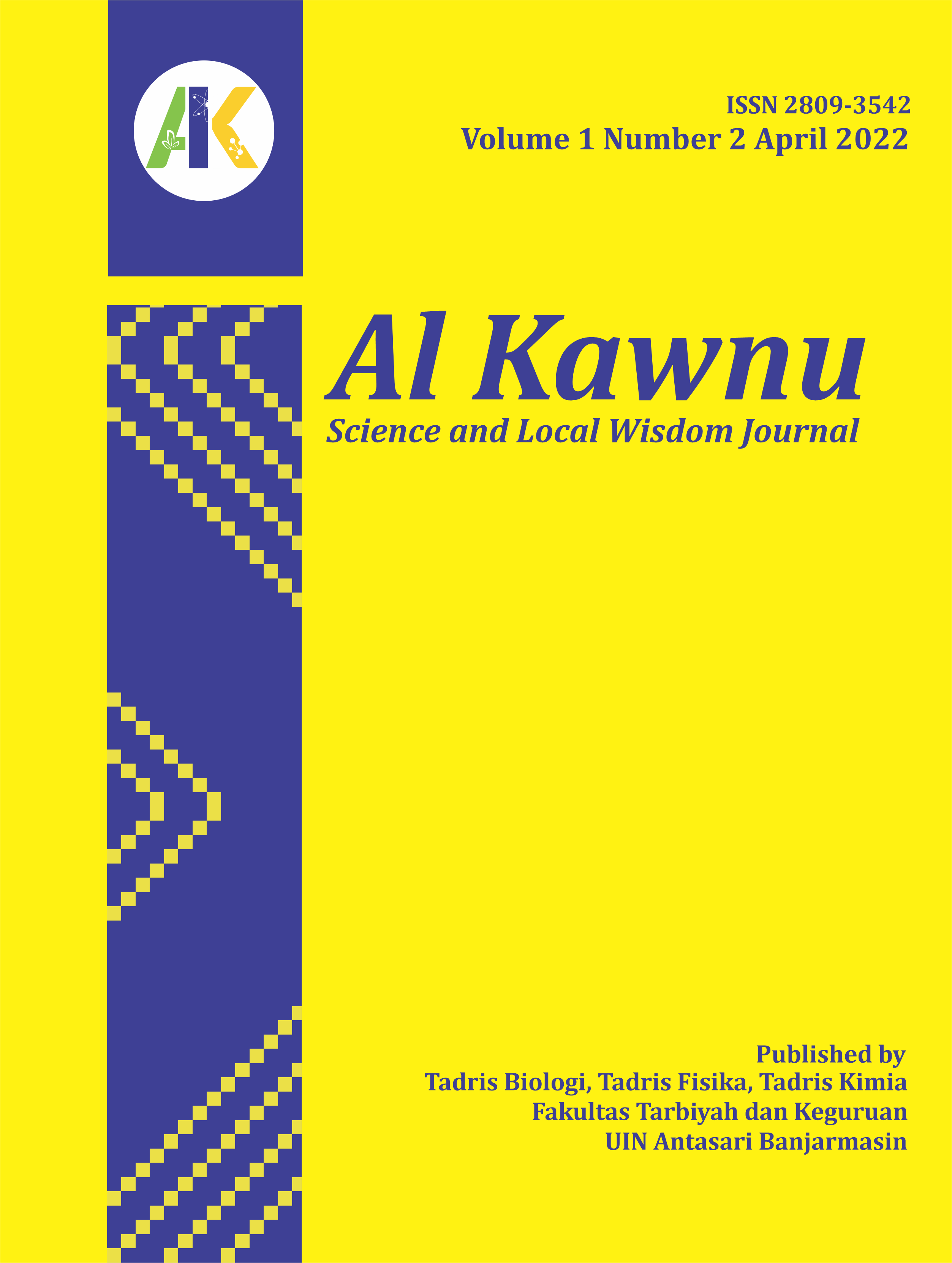Pemahaman Konsep Pada Materi Reaksi Redoks dengan Four-Tier Test
DOI:
https://doi.org/10.18592/ak.v1i2.6343Abstract
This study aims to determine the understanding of the redox reaction material concept of each subconcept in class X students of MAN 3 Hulu Sungai Selatan. The type of research used is descriptive statistics with a quantitative approach. The population of this study was students of class X MAN 3 Hulu Sungai Selatan with samples of class X MIA 1 and 2 totaling 63 people. Sampling technique used is Purposive Sampling. Data collection techniques were carried out using a four-tier diagnostic test. The results showed that the understanding of the concept of redox material with an average of 31.25% with moderate criteria. Understand the concept of redox reactions based on the binding and release of oxygen by 42.06%, redox reactions based on the attachment and loss of electrons by 26.98%, redox reactions based on increasing and decreasing oxidation numbers by 25.40%, determining the oxidation number of 58, 73%, oxidation-reduction reactions of 26.98%, oxidizing and reducing agents of 24.34%, and the application of redox reactions of 14.29%. Understanding the biggest concept is in the sub-concept of determining the oxidation number.References
Astutik, T. P. (2017). Identifikasi Konsep Sukar dan Kesalahan Konsep Reaksi Redoks. Jurnal Zarah, 5(1), 22–28. https://doi.org/10.31629/zarah.v5i1.155
Auliyani, A., Hanum, L., & Khaldun, I. (2017). Analisis Kesulitan Pemahaman Siswa pada Materi Sifat Koligatif Larutan dengan Menggunakan Three-Tier Multiple Choice Diagnostic test di Kelas XII IPA 2 SMA Negeri 5 Banda Aceh. Jurnal Ilmiah Mahasiswa Pendidikan Kimia, 2(1), Article 1. http://www.jim.unsyiah.ac.id/pendidikan-kimia/article/view/3403
Caleon, I. S. & Subramaniam, R. Do students know what they know and what they don’t know? Using a four-tier diagnostic test to assess the nature of students‘ alternative conceptions. Research in Science Education, 40, 313-337.(2010). (t.t.).
Gunandjar, G., Salimin, Z., Purnomo, S., & Ratiko, R. (2013). Proses Oksidasi Biokimia untuk Pengolahan Limbah Simulasi Cair Organik Radioaktif. Jurnal Forum Nuklir, 4(1), 13. https://doi.org/10.17146/jfn.2010.4.1.220
Irawati, R. K., & Sofianto, E. W. N. (2019). The misconception analysis of natural science students on heat and temperature material using four tier test. Journal of Physics: Conference Series, 1321(3), 032104. https://doi.org/10.1088/1742-6596/1321/3/032104
Jannah, R. R., & Utami, L. (2019). Identifikasi Miskonsepsi Siswa Pada Materi Reaksi Redoks Menggunakan Certainty Of Respond Indeks. Journal of The Indonesian Society of Integrated Chemistry, 10(2), 50–60. https://doi.org/10.22437/jisic.v10i2.5849
Kaltakci-Gurel, D., Eryilmaz, A., & McDermott, L. C. (2017). Development and application of a four-tier test to assess pre-service physics teachers’ misconceptions about geometrical optics. Research in Science & Technological Education, 35(2), 238–260. https://doi.org/10.1080/02635143.2017.1310094
McMurry, J. E., & Fay, R. C. (2003). Chemistry (Fourth Edition). Pearson College Div.
Oktaviany, D. N., & Majid, A. (2017). Penggunaan Model Pembelajaran Conceptual Change untuk Mereduksi Miskonsepsi Siswa pada Konsep Ikatan Kimia. Prosiding Seminar Nasional Kimia dan Pendidikan Kimia.
Purnamawati, H., Ashadi, A., & Susilowati, E. (2014). Pengaruh Model Pembelajaran Kooperatif Tipe Teams Game Tournament (TGT) dengan Media Kartu dan Ular Tangga Ditinjau dari Kemampuan Analisis Siswa terhadap Prestasi Belajar Siswa pada Materi Pokok Reaksi Redos Kelas X Semester 2 SMA Muh 1 Karanganyar. Jurnal Pendidikan Kimia, 3(4), 100–108.
Rizki, M., Nurhadi, M., & Widiyowati, I. I. (2020). Penerapan Model Pembelajaran Berbasis Masalah untuk Menurunkan Miskonsepsi Siswa tentang Konsep Reaksi Redoks. Jurnal Zarah, 8(1), 14–20. https://doi.org/10.31629/zarah.v8i1.1974
Sunarya, Y. (2012). Kimia Dasar 2.Bandung: Cv Yrama Widya
Suwarna, I. P. (2013). Analisis Miskonsepsi SMA Kelas X pada Mata Pelajaran Fisika mealui CRI (Certainty of Response Index) Termodifikasi. FITK UIN Jakarta.
Whitten, K. W., Stelzer, J., & Stanley. (t.t.). General Chemistry 7th Edition. Thomson.




